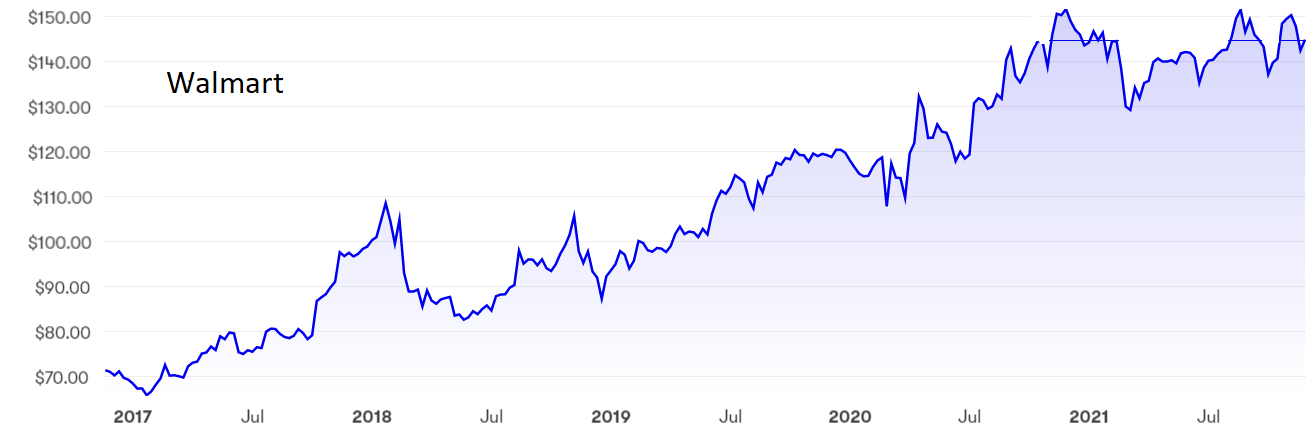Walmart: is the groceries Goliath going stale?
24th November 2021 08:51
by Rodney Hobson from interactive investor
Results from the world’s largest bricks and mortar retailer haven’t impressed our overseas investing expert, so is it time to sell? Here’s what Rodney Hobson thinks.

Rodney Hobson is an experienced financial writer and commentator who has held senior editorial positions on publications and websites in the UK and Asia, including Business News Editor on The Times and Editor of Shares magazine. He speaks at investment shows, including the London Investor Show, and on cruise ships. His investment books include Shares Made Simple, the best-selling beginner's guide to the stock market. He is qualified as a representative under the Financial Services Act.
Supply chain issues and a shortage of staff are holding back retail giant Walmart (NYSE:WMT). Investors must decide if they share management’s optimism that the Christmas quarter will be better than expected.
Walmart reported a $4.14 billion pre-tax profit in the three months to 31 October, down 42% compared with the same period in 2020. While this was caused in part by an accounting technicality – a $2.41 billion loss on paying off debt, which in itself is no bad thing – there was a heavy slippage in gross margins. Earnings per share slumped from $1.80 to $1.11.
On the brighter side, revenue grew 4.3% year-on-year to $140.5 billion thanks to a spurt in sales in the United States. Here again, though, there was bad news. Sales in the international arm covering mainly Canada, Mexico and Central America, where margins have been higher, slumped 20%.
- Why I’m buying ‘value’ stocks and other top tips
- Ian Heslop's outlook for the US stock market in 2022
- Bill Ackman: hot sectors and the economy in 2022
- Want to buy and sell international shares? It’s easy to do. Here’s how
The overall picture continues a trend that has been running throughout Walmart’s current financial year since the end of January. Revenue over the past nine months has risen 3.1% but profits have fallen 34%, not at all the combination that shareholders want to see.
Walmart has difficulties that affect the entire retail and wholesale markets. One is in logistics, with the cost of fuel rising rapidly in line with crude oil prices. This is particularly troublesome in the US, where fuel prices have tended to be lower than in most developed countries. Another issue is the widespread shortage of lorry drivers and, while that particular problem does seem to be easing, the solution involves raising their wages.
That same solution has been applied to Walmart’s staff shortages in its hypermarkets, discount department stores and grocery stores. It is seeking 150,000 new workers, mostly for permanent full-time positions.
Even before that decision was announced, the company had raised wages by at least $1 an hour for its 565,000 American employees in order to retain their loyalty in a tight labour market. Walmart is competing with restaurants, delivery companies, supermarkets and other chains that have also raised wages.
Walmart's starting wage is now between $12-17 an hour and the average hourly wage will be $16.40, which is higher than union leaders are demanding in the sector.

Source: interactive investor. Past performance is no guide to future performance
Despite these difficulties, Walmart raised its earnings guidance for the full financial year, suggesting sales growth of 6% and earnings per share slightly above the previous guidance of $6.20-6.35. It says it is gaining market share in grocery sales.
Whether those hopes are realised depends on whether consumers splash the cash this year to make up for last year’s pandemic-forced restraint. It is possible that they already have done, buying early to boost October’s spending – with retail sales up 1.7% – and raising false hopes by merely pulling purchases forward. Plans by the US central bank, the Fed, to scale back economic stimulus measures could burst the festive bubble.
Although its problems are similar, home improvement retailer Home Depot (NYSE:HD) seems to be in a better place. The trend for DIY projects has persisted despite the lifting of lockdowns.

Source: interactive investor. Past performance is no guide to future performance
Pre-tax profits rose 21% to $5.47 billion in the three months to September, while sales improved 9.8% to $36.8 billion. Net earnings per share improved from $2.08 to $3.86.
Walmart shares have baulked three times around $150 and may have difficulty breaking higher. At the current $145, the yield is 1.54%. Home Depot shares have risen pretty steadily over the past five years from around $120 to top side of $400, where they yield 1.58%.
- Bill Ackman: an industry as certain as food and oxygen
- Bill Ackman: why I've bet $100 billion on this event
- Take control of your retirement planning with our award-winning, low-cost Self-Invested Personal Pension (SIPP)
Hobson’s choice: If you’re already in, both shares rate a “hold” but of the two, Home Depot looks the better buy at this stage. I recommended Walmart at up to $119 two years ago and it wouldn’t be wrong to take profits.
Rodney Hobson is a freelance contributor and not a direct employee of interactive investor.
These articles are provided for information purposes only. Occasionally, an opinion about whether to buy or sell a specific investment may be provided by third parties. The content is not intended to be a personal recommendation to buy or sell any financial instrument or product, or to adopt any investment strategy as it is not provided based on an assessment of your investing knowledge and experience, your financial situation or your investment objectives. The value of your investments, and the income derived from them, may go down as well as up. You may not get back all the money that you invest. The investments referred to in this article may not be suitable for all investors, and if in doubt, an investor should seek advice from a qualified investment adviser.
Full performance can be found on the company or index summary page on the interactive investor website. Simply click on the company's or index name highlighted in the article.
Disclosure
We use a combination of fundamental and technical analysis in forming our view as to the valuation and prospects of an investment. Where relevant we have set out those particular matters we think are important in the above article, but further detail can be found here.
Please note that our article on this investment should not be considered to be a regular publication.
Details of all recommendations issued by ii during the previous 12-month period can be found here.
ii adheres to a strict code of conduct. Contributors may hold shares or have other interests in companies included in these portfolios, which could create a conflict of interests. Contributors intending to write about any financial instruments in which they have an interest are required to disclose such interest to ii and in the article itself. ii will at all times consider whether such interest impairs the objectivity of the recommendation.
In addition, individuals involved in the production of investment articles are subject to a personal account dealing restriction, which prevents them from placing a transaction in the specified instrument(s) for a period before and for five working days after such publication. This is to avoid personal interests conflicting with the interests of the recipients of those investment articles.